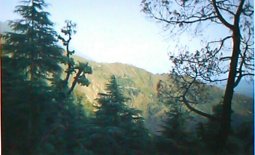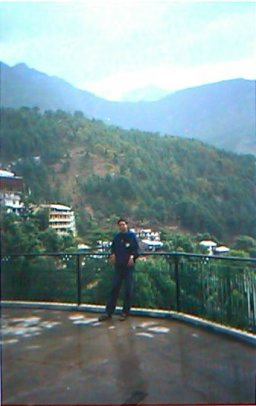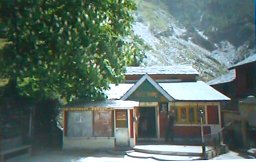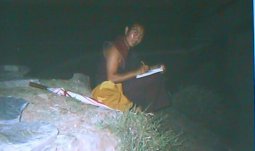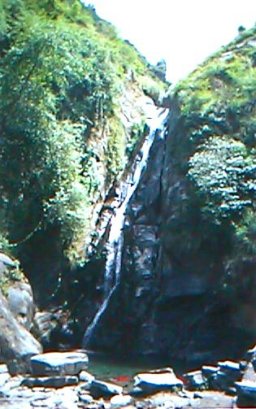|
All images and text are copyright protected. Contact
|
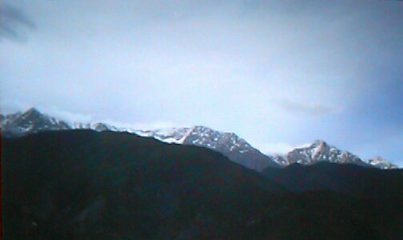 McLeod Ganj | Dharamsala The bus turns off the main road, away from the hot, dusty towns of Punjab, and begins climbing through green hills and narrow streets lined with shops bulging with backpacks and clothes. The air grows cooler and cleaner and I am thankful for the change from the terrible heat of Rajasthan. The higher mountaintops are covered in snow, typical of the hilly state of Himachal Pradesh which means 'Lap of Snow'. At 3:15 pm, we come to Lower Dharamsala, a small, pretty, jumbled town sprawled on a hillside. Sixteen kilometers further on and 500 meters higher up, among a tangle of pine trees and an army station, is Upper Dharamsala, McLeod Ganj, home of the Dalai Lama and the Tibetan Government in exile since 1959. Named after a Punjab governor, Mcleod Ganj was a British hill station chosen, no doubt, for its scenic beauty and cool climate or perhaps because it reminded them of England. Quite a few of these Colonial Brits, their wives and children today lie in the cemetery of the still functioning Anglican St. John's Church set among shady trees just outside of the town.
Although the town lies among rugged snowy mountains much more forested than Tibet, any impressions of wild remote areas are quickly dispelled on arrival. The bus plonks us down in the main bus circle where one is immediately met by restaurants offering American, Mexican, French, German, Italian, Israeli, Tibetan, Japanese, Chinese, Korean, vegetarian or macrobiotic meals and take-away. The effect is reinforced by advertisements for meditation classes, Thai massage, the healing power of crystals, shiatsu and Reiki, Tibetan language and culture courses and 1960's funky clothes. The cause of the Dalai Lama and the Tibetan Government in exile has been picked up by many support groups and the Dalai Lama himself has travelled extensively giving talks which has made Dharamsala a cosmopolitan Mecca for peace-loving peoples who also happen to be quirkier than the average traveller. In some ways Dharamsala reminds me of a smaller version of Kathmandu.
At Tsuglagkhang, the Main Temple, in front of the Dalai Lama's residence, the monks engage in debate. In pairs, they argue theology, snapping their fingers, clapping their hands, stamping their feet as they make their points. The Temple is very different to the Potala, the former residence of the Dalai Lama in Lhasa. Tsuglagkhang is more modern, smaller, simpler, less labyrinthine. His Holiness' residence lies behind not-very-high walls with a guard at the door, yet it doesn't appear forbidding or inaccessible. There are notices posted on a bulletin board with information on applying for an audience. We fall in with groups of people walking clockwise around the walls like pilgrims at Barkhor Square circumambulating the Jokhang. Not far away is the Tibet Museum, a modern building with a superb exhibition and installation "A Long Look Homeward" – photographs and a video of Tibetan resistance of the occupation by the Chinese and their often tragic stories of walking over snow and ice to freedom, losing limbs to frostbite, or small children and elderly relatives to the cold.
Up Bhagsu Road on the outskirts of town, we come to the Hindu Bhagsu-Nag Temple, a small complex of shrines with a small swimming pool. 9000 years ago, King Bhagsu fought the snake god, Sheshnaag (Nag), for water to save his people dying from drought in Ajmer in Rajasthan. The snake god won the battle, but the dying Bhagsu pleaded for his people so pitifully that Nag felt compassion and created the canal that today irrigates most of Rajasthan. In the small pools in front of the temple, groups of students swim in the holy waters. Further on, the road winds up the hill and along a rocky river where I stop at a roadside café for a cold drink and a breath of clean air away from the town. Here, away from the commerce and bustle, looking down into the valleys of pine trees, Dharamsala seems peaceful and calm. Though the Tsuglagkhang and the Dalai Lama's residence are only a stone's throw away, it is here in the mountains (and in those of Tibet and western China) that I feel the spirituality that probably brought the Dalai Lama and his followers here 42 years ago. In the river below, singing sutras and making jokes, monks wash their red and yellow robes and tunics.
"No, there are no buses to Srinagar," they say. "But you have an advertisement on your wall for buses to Srinagar," I point out, naively. "The person in charge of Srinagar tickets is not here today," they say. He comes back late in the night with tales of adventure. "I was going up the mountain and I got lost when the trail stopped. So I walked straight down the hill and fell down." "Were you hurt?" I ask. "No, and the camera was also okay. Then, not far from Bhagsu-Nag, I met a monk sitting on a hill. He was studying but chatted with me. He is learning English. He has been here only three weeks. And after, I took the bus down to Lower Dharamsala to look around. When I was ready to come back it was night and the local buses had stopped running." "So what did you do?" "I began walking back along the road. And then, just outside of Lower Dharamsala, a woman came out of her house to tell me not to walk in the dark because there are tigers around here." "Tigers!" I cry out. "Yes. Then her son and his friend came out and said that I should wait awhile for the bus from Delhi and I could take it to come back." "Did you have to wait long?" "About three hours. She waited with me, standing in the road, until the bus came. Her son's friend came with me, too." "You were almost dinner for a hungry tiger!" "Yes. I was lucky."
Raceandhistory.com | Howcomyoucom.com | Trinicenter.com | TriniView.com Another 100% non-profit Website serving poorly represented communities. Copyright & Disclaimer. - - Privacy Policy --Designed & maintained by S.E.L.F. © 2002 TriniView.com |

